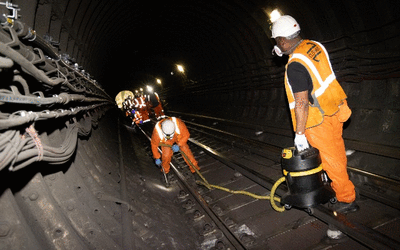Improving air quality on the Tube
 Cleaning team using vacuums on tunnel walls and floor
Cleaning team using vacuums on tunnel walls and floor
We need to reduce dust on the Tube so the air quality there stays safe for our staff and customers.
Dust on the Tube is made up of a mix of:
- Metal particles - most of which are iron oxide, caused by track and wheel wear and braking
- Organic matter like skin and hair
- Mineral dusts
Our monitoring shows that dust levels on the Tube remain below occupational limits set by the Health and Safety Executive (HSE), but we're not complacent.
What we're doing
We tackle Tube dust on our network with extensive cleaning and monitoring, and by exploring the latest innovations and commissioning world-leading research.
We take a targeted approach to reduce Tube dust levels in the most-affected areas, with specific cleaning in places where our monitoring has shown higher dust levels. We've increased our annual Tube dust cleaning budget by a third to £2m and have also introduced innovative new cleaning methods, including mobile backpack vacuum cleaners.
This approach is getting results. Since 2019 in-station dust levels on the Tube have been reduced by 30% and in the driver's cab by 27%.
We've also commissioned more research to make sure we understand any potential health impacts as fully as possible. The first of these studies was published in March 2024.
Monitoring
We use an independent company to do annual air quality monitoring across the Tube network. Besides dust levels on the Tube being below HSE occupational limits, levels on most of our network are also below the recommendations from the Institute of Occupational Medicine, which are set significantly lower.
Specialist, calibrated equipment is used in this monitoring - this is likely to achieve more accurate and detailed results than personal, portable devices.
Our monitoring results are available on the Environment monitoring & reporting page.
Tube dust and health
At our request, the Government's Committee on the Medical Effects of Air Pollutants (COMEAP) reviewed the evidence on the health effects of particulate matter in the Tube.
COMEAP said in 2018 that there was not enough evidence at that time to determine the health impact of underground particulate matter and that more research is needed.
Tube dust vs outside air pollution
Air quality underground is different from the ambient air on the surface. Above ground, common air pollutants such as nitrogen dioxide and diesel exhaust emissions have been identified as harmful to humans - these are not found inside the Tube network.
A strong body of evidence shows the impact on health from exposure to this outdoor pollution from exhaust emissions.
Travel on the Tube reduces exposure to pollutants from road traffic.
Find out what we're doing to improve London's air quality.
What's next
We're already planning how we will significantly reduce the production of, and exposure to, Tube dust in the long term. This includes investment in new trains and other track infrastructure. For example, the modern braking systems on new Piccadilly line trains being introduced from 2025 will create less dust.
We're also exploring potential new innovations to reduce dust levels, including new air filtration systems aimed at capturing airborne dust.